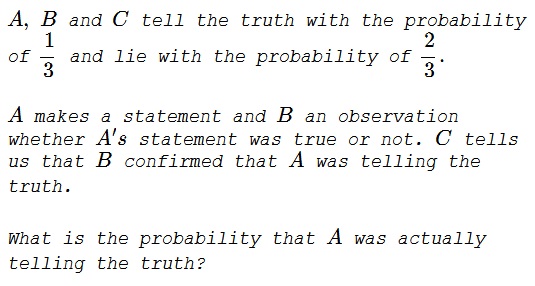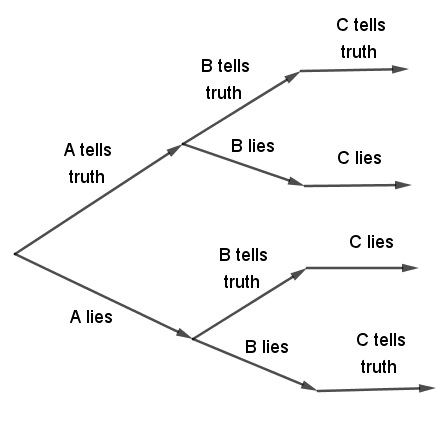A Problem of Three Liars
Problem

Solution 1
The tree below represents all possible cases wherein $C$ tells us that $B$ confirmed $A's$ statement.

Counting the probabilities gives for the total
$\displaystyle\begin{align} P&=\frac{1}{3}\cdot\left(\frac{1}{3}\cdot\frac{1}{3}+\frac{2}{3}\cdot\frac{2}{3}\right)+\frac{2}{3}\cdot\left(\frac{1}{3}\cdot\frac{2}{3}+\frac{2}{3}\cdot\frac{1}{3}\right)\\ &=\frac{13}{27}. \end{align}$
This corresponds to $13$ cases out of $27$ wherein $C$ tells us that $B$ confirmed $A's$ statement. The first addend in the above corresponds to $1\cdot 1+2\cdot 2=5$ cases wherein $A's$ statement was indeed true. So, with the information at hand, we may conclude that the probability that $A$ was telling the truth is $\displaystyle \frac{5/27}{13/27}=\frac{5}{13}.$
Solution 2
Let $t=1/3$ and $f=2/3$.
$\begin{array}{c|c|c||c||c} \textbf{A speaks} & \textbf{B speaks} & \textbf{C speaks} & \textbf{C can} & \textbf{Probability} \\ \textbf{truth} & \textbf{truth} & \textbf{truth} & \textbf{make the} & \\ & & & \textbf{statement} & \\ \hline 0 & 0 & 0 & 0 & f^3 \\ 0 & 0 & 1 & 1 & tf^2 \\ 0 & 1 & 0 & 1 & tf^2 \\ 0 & 1 & 1 & 0 & t^2f \\ 1 & 0 & 0 & 1 & tf^2 \\ 1 & 0 & 1 & 0 & t^2f \\ 1 & 1 & 0 & 0 & t^2f \\ 1 & 1 & 1 & 1 & t^3 \end{array}$
$\displaystyle \begin{align} &P(\text{A speaks truth}|\text{C can make the statement}) \\ &\qquad\qquad =\frac{P(\text{A speaks truth}\cap\text{C can make the statement})} {P(\text{C can make the statement})} \\ &\qquad\qquad =\frac{tf^2+t^3}{3tf^2+t^3} =\frac{t^2+f^2}{t^2+3f^2} =\frac{1^2+2^2}{1^2+3\cdot 2^2} =\frac{5}{13}. \end{align}$
If the properties in the first four columns of the above truth table are labelled by $P_k$ where $k$ is the column number, then the above truth table gives $P_4$ as
$ \overline{P_1}.\overline{P_2}.P_3+\overline{P_2}.\overline{P_3}.P_1+\overline{P_3}.\overline{P_1}.P_2+P_1.P_2.P_3$
using logic gates or as
$\small{((\lnot{P_1})\land(\lnot{P_2})\land P_3)\lor((\lnot{P_2})\land(\lnot{P_3})\land P_1)\lor((\lnot{P_3})\land(\lnot{P_1})\land P_2)\lor(P_1\land P_2\land P_3)}$
using propositional logic.
Acknowledgment
This is a paraphrase of problem 2.4.10 from R. Falk's Understanding Probability and Statistics (A K Peters, 1993).
Solution 2 is by Amit Itagi.
|Contact| |Front page| |Contents| |Probability|
Copyright © 1996-2018 Alexander Bogomolny73574205
